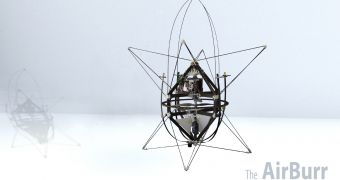Anyone who thought the GimBall was the only weird thing to come out of EPFL's labs recently can count themselves proven wrong. Scientists from the Ecole Polytechnique Federale de Lausanne have also made the AirBurr.
There are quite a few things in common between the two. Like GimBall, Airburr is made of wires/thin pins, of a sort. Or at least the outer harness is.
The actual flying robot is the one in the middle. The segments all around it are there to protect it from collisions, and to actually recognize when collisions happen.
Which is to say, the AirBurr can “feel” if it comes into contact with something thanks to integrated sensors.
AirBurr can even learn from those collisions, to the point where it can fly autonomously in a small room. No height or distance sensors are used. It can even “remember” the things cluttering the environment.
What's more, unlike the GimBall, which is specifically made for exploration, this one can be used in search and rescue operations, because it can latch onto things and stay still.
Thus, the AirBurr could be “loaded” with something, like light kits of medical supplies, or an end of a rope, then sent on its way to randomly search an area, just in case there are people in regions where rescuers can't reach.
The perching mechanism is really simple too, using a fiber-based adhesive. A deployable perching mechanism with gecko adhesives allows is to hang off walls. It's unclear how well the method works on non-flat and smooth surfaces, but the idea is a good start if nothing else.
You'll see the mechanism in action in the video embedded below. The mechanism that deploys the gecko adhesive pad (optimized for maximum attachment force) is one that stays within the structure of the robot during flight. The pilot controlling the AirBurr from afar can initiate a perching maneuver at any time. That done, the motors shut down to save energy.

 14 DAY TRIAL //
14 DAY TRIAL // 